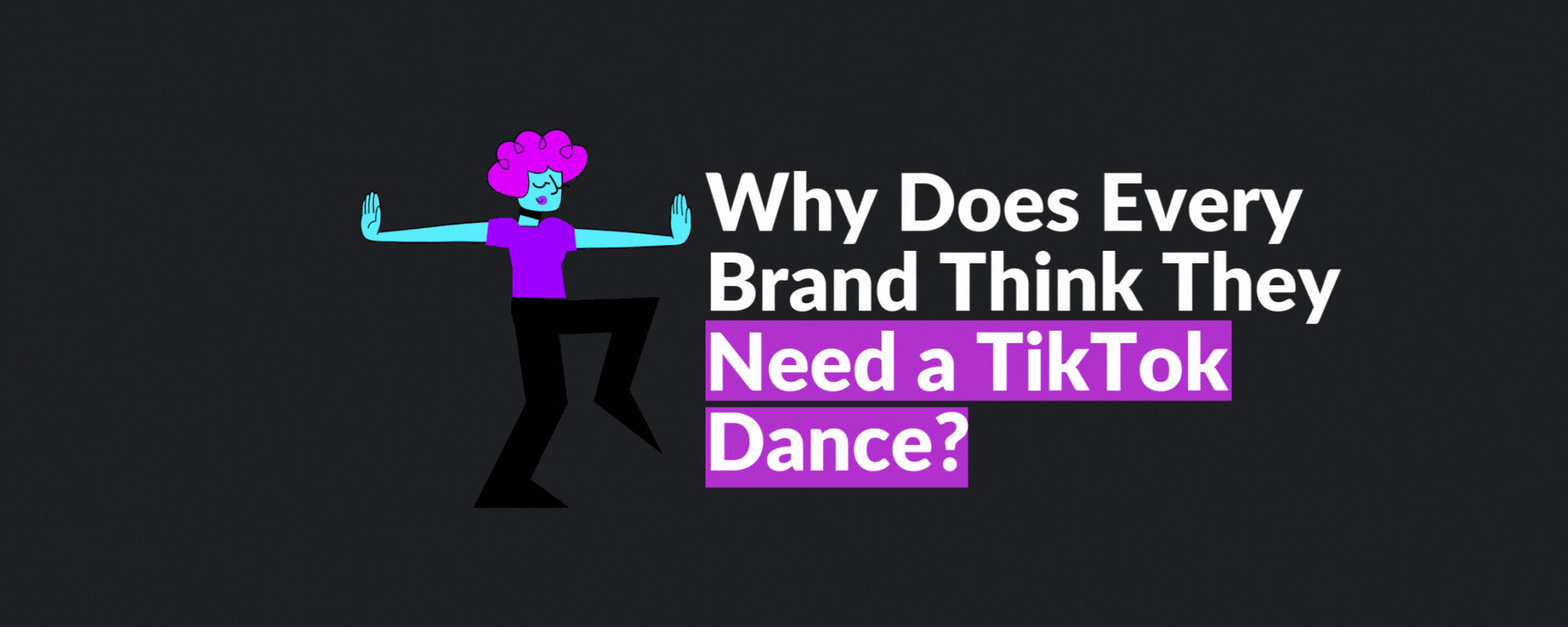Why Does Every Brand Think They Need a TikTok Dance?

Imagine you’re at a wedding. You’re sitting at your table, enjoying your dinner, when suddenly, your uncle decides to join the dance floor. Now, the problem isn’t that he’s dancing. The problem is, he’s attempting to replicate the latest TikTok dance — and failing, spectacularly. It’s awkward, a little bit cringy, and most of all, you wish he’d just sit down and be himself. This, my friends, is where brands find themselves today: awkwardly forcing their way into spaces they don’t belong, thinking a viral dance might just be the answer to all their engagement problems.
Now, don’t get me wrong. I have nothing against TikTok. The platform is powerful, dynamic, and offers incredible opportunities for brands. But does every brand need to jump on the TikTok dance trend? Let’s have an honest conversation about why this obsession persists — and more importantly, why it shouldn’t.
The Herd Mentality of Marketing
There’s something strangely comforting about not having to think. When brands see one brand go viral with a TikTok dance, the easiest thing to do is to follow suit. It’s the same psychological mechanism that makes people follow the herd — it feels safer. If everyone else is doing it, then it must be the right move, right? Except when it’s not.
This is where the real issue lies. Marketing, by its very nature, is supposed to differentiate. The idea is to stand out, not blend in. Yet, in a desperate attempt to appear relevant, brands often forget that the goal isn’t just to be seen — it’s to be remembered, to connect, and to leave a lasting impression. When every brand is doing the same dance, nobody remembers who did it first, or who did it best. They just remember that a bunch of brands tried, and many failed. So, instead of dancing, what if we took a step back and asked ourselves: what makes our brand truly unique?
The Illusion of Virality
Let’s talk about the idea of going viral. In the marketing world, “viral” has become a sort of holy grail — the measure of success for a piece of content. But here’s the thing: virality is fickle, unpredictable, and fleeting. A TikTok dance might make your brand trend for a day, but then what? The problem with chasing virality is that it’s like chasing a sugar rush — exhilarating while it lasts, but ultimately unsustainable. Virality can be a powerful boost for a brand, but only if it’s backed by substance and contributes to long-term goals like driving consistent engagement and repeat interactions over a 12-month period. If your goal is to build a brand that stands the test of time, you need more than just eyeballs — you need hearts and minds.
Authenticity is the Real Currency
We live in an age where consumers crave authenticity. They can spot an inauthentic attempt at relevance from miles away. And let’s face it: most TikTok dance attempts by brands come off as exactly that — inauthentic. It’s like trying too hard to fit in with the cool kids, and we all know how that ends.
The brands that succeed on TikTok are the ones that genuinely understand their audience, have a distinct personality, and create content that’s true to who they are. Take Dubai Tourism's #ThisisDubai campaign, which involved bespoke AR stickers and exclusive music. The campaign garnered over 30 million views and generated almost 10,000 user-created videos, showcasing how culturally relevant and authentic content can truly resonate with audiences in a specific region. Their quirky, playful persona works because it’s genuine. When they do something silly, it doesn’t feel forced. They’re not trying to be something they’re not — they’re simply amplifying who they already are.
So, instead of asking, “What’s the latest TikTok trend we can jump on?” brands should be asking, “What can we create that’s true to us?” In other words, how do we show up as ourselves, in a way that’s meaningful to our audience?
TikTok's Algorithm and the Myth of One-Size-Fits-All
TikTok’s algorithm is a fascinating beast. It’s designed to serve content that resonates with individuals, based on their interests, behaviors, and interactions. This means that just because a dance trend worked for one brand doesn’t mean it will work for yours. TikTok rewards content that feels real, that strikes a chord with a specific audience.
This is why the one-size-fits-all approach to TikTok marketing is fundamentally flawed. What works for a fast-food chain might not work for a financial institution. The key is understanding not just the platform, but your audience within that platform. If your audience isn’t likely to care about dance challenges, then why force it? The algorithm will reward content that speaks directly to the interests of your audience, not just content that happens to be trending.
In 2024, TikTok is evolving. It’s not just about dances anymore; it’s about storytelling, authenticity, and community. The brands that succeed are those that adapt to this shift, not the ones still clinging to last year’s dance craze.
The Long Game: Building Meaningful Connections
There’s a misconception that TikTok is all about quick wins. And yes, the platform can deliver those — but it can also be a powerful tool for building long-term relationships. The key is to focus on creating content that resonates beyond the fleeting moment. For instance, Kraft Foods successfully leveraged TikTok in Saudi Arabia to boost sales by embracing content that was not just trendy but also meaningful. By focusing on culturally relevant themes and partnering with local creators, Kraft Foods saw a 1.8x higher return on ad spend compared to the regional digital benchmark. This success underscores the importance of community engagement and regional relevance in content creation. Think about the brands that have managed to carve out a space for themselves on TikTok — they’re not just chasing trends; they’re creating value, telling stories, and engaging in a way that’s consistent with their brand.
If we go back to the wedding analogy, the brands that succeed on TikTok aren’t the ones awkwardly trying to replicate the latest dance move. They’re the ones who know when to join in, when to sit back, and most importantly, when to create their own dance. They understand that it’s not about trying to be something they’re not — it’s about being the best version of themselves, in a way that’s genuine and relatable.
According to a recent report by Influencer Marketing Hub, TikTok's unique engagement lies in fostering authentic interactions. In fact, 78% of TikTok users reported purchasing a product after seeing it featured by an influencer, highlighting the power of genuine engagement over simply following trends[1]. This speaks volumes. People aren’t looking for brands to be trendy — they’re looking for brands to be real. They’re looking for connection, for value, and for content that speaks to them on a deeper level.
The Good, the Bad, and the Cringe
Let’s look at a few real-world examples. Duolingo, as mentioned earlier, is a great case study. Their content is playful, consistent, and aligns perfectly with their brand personality. They’re not trying to be something they’re not — they’re simply being Duolingo, and that’s what makes their content work.
On the flip side, consider brands that have attempted to jump on TikTok dance trends without a clear connection to their brand identity. WesBank, a financial services provider in South Africa, recently tried to create a dance challenge, and the result was — unsurprisingly — a disaster. Their frequent TikTok posts did not resonate with the audience, as they failed to align the content with their brand identity, resulting in low engagement and minimal follower growth. The audience saw right through it. It felt forced, awkward, and completely disconnected from the brand’s core values, much like what happened with WesBank's attempt to connect through dance challenges without a clear strategy. It’s the marketing equivalent of that uncle at the wedding trying too hard to be cool. Maybe TikTok dances are best left to teenagers — or at least brands that know how to groove.
The lesson here is simple: if you’re going to jump on a trend, make sure it aligns with who you are. And if it doesn’t, don’t be afraid to sit that one out. There’s more to TikTok than dancing. The brands that understand this are the ones that will build lasting connections with their audience.
Finding Your Own Rhythm
So, where does that leave us? The truth is, not every brand needs a TikTok dance. What every brand does need, however, is a clear sense of who they are and how they want to show up in the world. It’s about finding your own rhythm, one that aligns with your brand identity and resonates with your audience.
TikTok is an incredible platform for those willing to be genuine, to experiment, and to connect on a human level. But it’s not about copying what everyone else is doing — it’s about understanding your audience, knowing your brand, and creating content that’s true to both. In a world where everyone is trying to be the next viral sensation, the real power lies in being the brand that’s authentic, consistent, and memorable.
So, the next time you find yourself asking whether your brand needs a TikTok dance, take a moment to think: What unique aspect of your brand can you highlight today, without following the crowd? Does it align with who you are? Does it add value to your audience? If the answer is no, then perhaps it’s time to sit this one out and focus on what really matters — building real, lasting connections that go beyond the latest trend.
[1] Source: Influencer Marketing Hub, "TikTok Marketing Report 2024 – Key Trends, Statistics, and Insights". Available at Influencer Marketing Hub.


Discussion